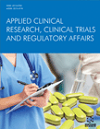- Home
- A-Z Publications
- Applied Clinical Research, Clinical Trials and Regulatory Affairs
- Previous Issues
- Volume 4, Issue 1, 2017
Applied Clinical Research, Clinical Trials and Regulatory Affairs - Volume 4, Issue 1, 2017
Volume 4, Issue 1, 2017
-
-
Microbial and Non-microbial Pyrogens in Healthcare Products: Risks, Quality Control and Regulatory Aspects
More LessAuthors: Nasib Singh, Tanuja Mishra, Karan Singh and Joginder SinghBackground: Pyrogens are fever causing microbial and non-microbial constituents of variable chemical composition. Their presence in dialysis fluids, parenteral drugs, biopharmaceuticals, cosmetics and on solid medical devices is considered a major health concern worldwide. The main aim of this review is to summarize the scientific literature accumulated during the last few decades concerning health risks of pyrogens Read More
-
-
-
Regulatory Requirements for Medical Devices: An Insight
More LessAuthors: Onkar Bedi, Pawan Krishan and Gaaminepreet SinghThe medical device includes a variety of sophisticated, simple and newer equipments, such as tongue depressors, hemodialysis machines, PET (Positron emission tomography), MRI (Magnetic resonance imaging) scanners and magneto encephalography devices etc. The regulation of these devices has become advanced and more effective to produce continuous and steady regulatory perspective. There are different regulat Read More
-
-
-
Herbal Health Products Quality through Stability Studies: A Global Regulatory Concern
More LessAuthors: Gulshan Bansal, Ishtdeep Kaur and Jasmeen KaurHerbal medicinal products are widely used for treatment of almost all human ailments in traditional systems of medicines. These are consumed not only as medicinal products but also as dietary supplement products to improve one's health. So, both types of these herbal products can be collectively termed as herbal health products. Growing demand of these health products in global market has raised issues on the qualit Read More
-
-
-
Safety, Quality and Regulatory Aspects of Nutraceuticals
More LessAuthors: Shikha Girdhar, Deepti Pandita, Amit Girdhar and Viney LatherBackground: Nutraceuticals are the concentrated nutrients that are isolated from food or food products and have therapeutic and preventive qualities. They are gaining wide popularity because beyond providing basic nutrition, they have several health benefits. The global nutraceutical market is forecasted to reach $ 241.1 billion by 2019. However, the safety and quality of nutraceuticals are the major issues that need a Read More
-
-
-
Regulatory Requirements for Collection, Administration and Transfusion of Blood and Blood Products
More LessAuthors: Monika Rani, Raghuvansh Kumar, Gagandeep Kaur and Pawan KrishanBlood is considered as a life saving tissue. World Health Organization (WHO) has considered “Blood” under the definition of “Drug,” in Drug and Cosmetic Act, 1940. For the first time, in 1975, WHO World Health Assembly (WHA) under the resolution WHA (28.72), established the principles and guidelines for the managed and coordinated blood systems. For over fifty years, expert committee on biological standardization (ECBS), Read More
-
-
-
Connected Health: An Open Innovation Perspective
More LessAuthors: Anushree Priyadarshini, Maria Quinlan and Gerardine DoyleThe concept of connected health has gained traction in recent years as a new technology enabled and networked model of health care delivery. It is often used as an umbrella term for eHealth, digital health, health informatics, telemedicine, mHealth and involves the establishment and management of a network of stakeholders with the aim of improving health care quality and outcomes. Yet a lack of open interactions a Read More
-
-
-
Selective Identification and Charcterization of Potential Probiotic Strains: A Review on Comprehensive Polyphasic Approach
More LessAuthors: Malika Arora and Ashish BaldiBackground: Probiotic constitutes viable microorganisms that exhibit a beneficial effect on the host. Due to rapidly increasing awareness among consumers about wide therapeutic applications of probiotics, plenty of commercial probiotic formulations are entering to the market, hence market has shown significant rise has been observed in recent years. Probiotic products are gaining popularity across the globe, under different Read More
-
-
-
A Comprehensive Analysis of Reasons for Neglected Status of Institutional Ethics Committees (IECs) in Health Research Institutes of Punjab, India
More LessAuthors: Ramandeep Kaur, Vikas Gupta, Ajay Francis Christopher and Parveen BansalBackground: Institutional Ethics Committees (IECs) in India are in their infancy stage which has significant implications in context to oversight of the protection of human participants. The critical and first step to support the protection of research participants and improve the scientific quality of health research is to understand how these IECs currently function. Objective: Authors assessed the functioning of IECs to understand th Read More
-
Most Read This Month
Article
content/journals/acctra
Journal
10
5
false
en

Most Cited Most Cited RSS feed
-
-
-
A Rapid LC-ESI-MS/MS Method for the Quantitation of Salicylic Acid, an Active Metabolite of Acetylsalicylic Acid: Application to in vivo Pharmacokinetic and Bioequivalence Study in Indian Healthy Male Volunteers
Authors: Dhiman Halder, Shubhasis Dan, Easha Biswas, Pradipta Sarkar, Umesh C. Halder and Tapan K. Pal
-
- More Less

